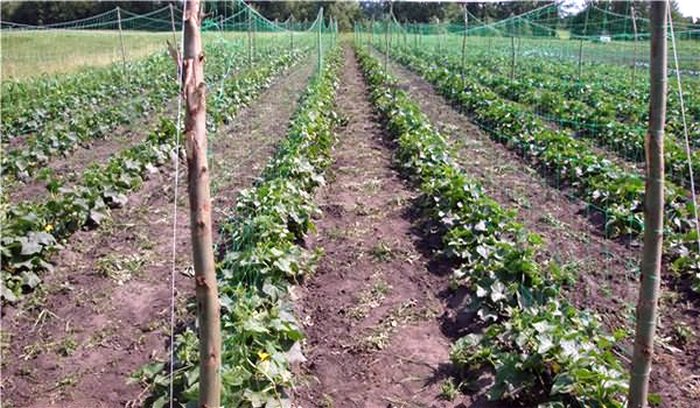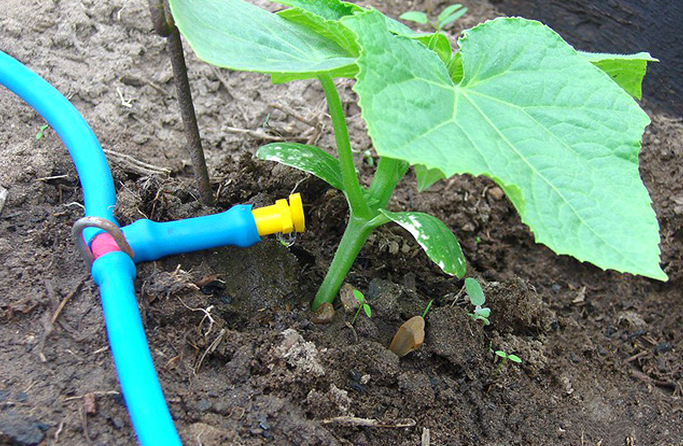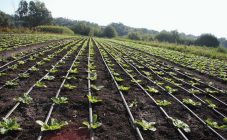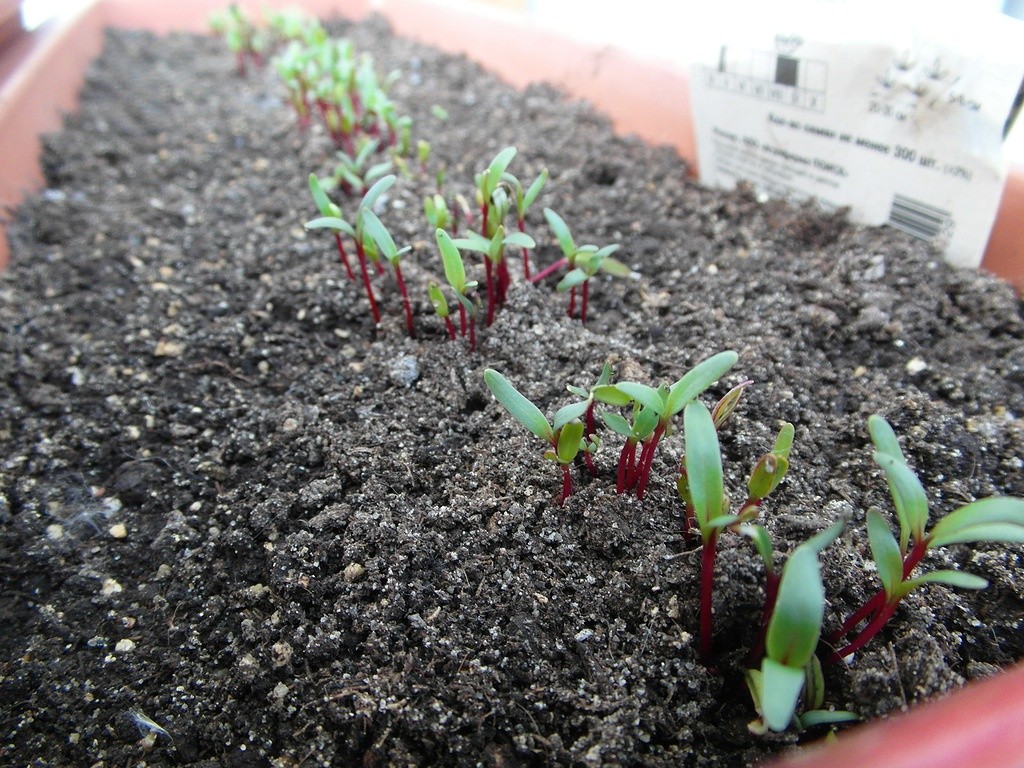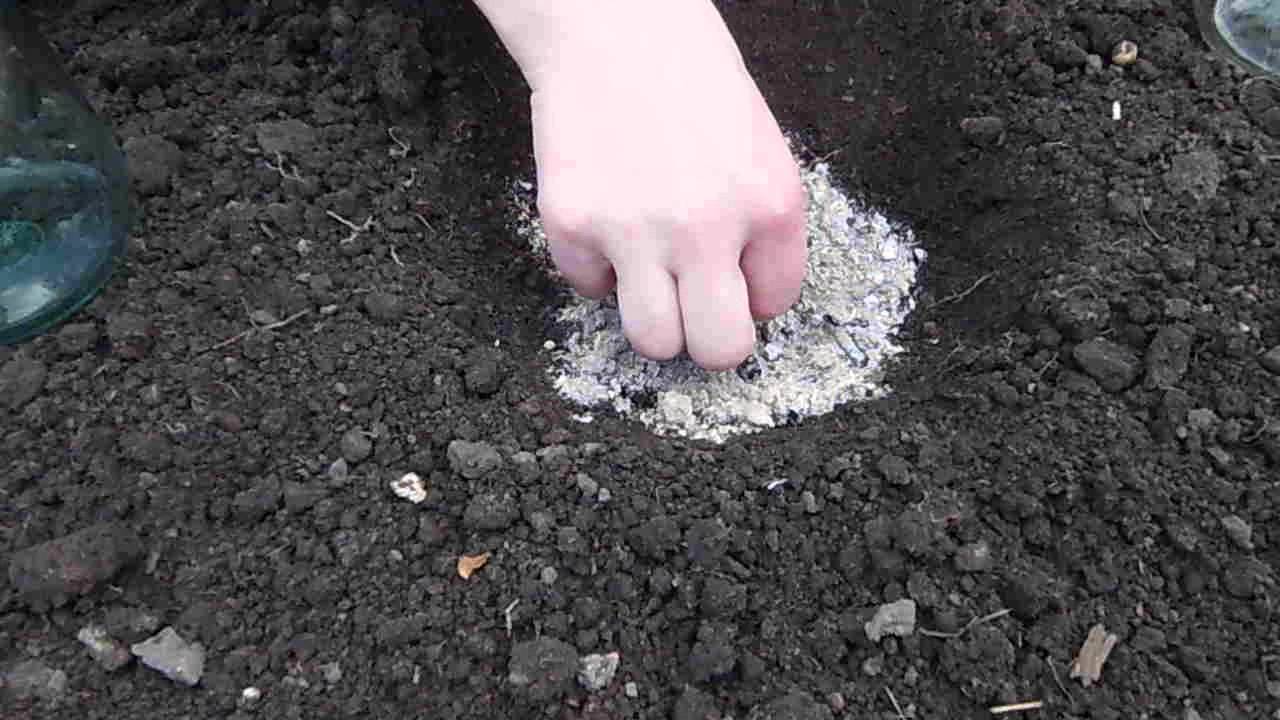Content:
Cultivation of cucumbers in open ground by direct sowing does not provide for pre-planting seeds for seedlings and the presence of perennial protective structures (greenhouses, hotbeds) on the site. In order to get a high yield of ground cucumbers, it is necessary to sow them correctly.
Conditions for growing cucumbers in the open field
To obtain the desired yield of ground cucumbers, you need to familiarize yourself with the crop requirements for growing conditions.
- Cucumber belongs to moisture-loving vegetables, it prefers frequent and abundant watering.
- The culture grows well in sunny areas, and also bears fruit normally in a light openwork shade. The optimum temperature for growth and fruiting ranges from + 24 ° C to + 28 ° C. At higher (as well as at lower) temperatures, development stops.
- Cucumbers need good nitrogen nutrition for harmonious growth and development. Potassium and phosphorus are consumed in smaller amounts.
- The culture prefers to grow on loose soils. Good air permeability of the earth will not allow excess moisture to accumulate.
If you provide all the above conditions with cucumbers in the open field, then the plants will be healthy, and the yield will be high.
When to sow cucumbers in open ground
In different regions of the country, the specific landing date directly depends on the weather conditions. In general, sowing is carried out from mid-spring to July.
To choose the most suitable day for planting ground cucumbers with seeds, it is important to focus on the weather in the region. For cucumbers to grow well and amicably, the soil temperature must be at least + 13 ... + 15 ° С.
Most experienced gardeners, when carrying out this or that event on the site, rely on the recommendations of the lunar calendar of the gardener and gardener. In such a calendar, depending on the phase of the moon and the sign in which it is located, the most favorable and unfavorable dates for work are set. The lunar calendar for 2018 recommends sowing cucumbers:
in April: 2, 3, 20 ... 21, 24 ... 26, 29.
in May: 6, 9 ... 11, 18 ... 19, 24 ... 28.
in June: 3 ... 5, 10 ... 11, 15, 23 ... 24.
Preparing seeds for planting in open ground
If the planting material was purchased in a store, then its preliminary processing is unlikely to be required - most manufacturers disinfect and cover the seeds with a protective shell, so it is not recommended to soak them. These seeds are planted dry.
If the planting material was collected with one's own hand from previously grown varieties of cucumbers, then it is advisable to carry out a full complex of its preliminary preparation, consisting of several stages.
Calibration
At this stage, it is proposed to select the largest, even and naturally colored cucumber seeds for planting, and discard all deformed and diseased seeds.Then you can use a saline water solution, which is prepared at the rate of 30 g / l of water, place the seeds there and mix. Those that floated to the surface of the liquid are not suitable for planting. The rest must be laid out and dried. The disadvantage of this calibration method is its narrow application - the method is suitable only for freshly harvested planting material of cucumbers with a maximum shelf life of 2 years.
Disinfection
Seeds can be etched in various ways: soaking in solutions of potassium permanganate or special preparations, or by heating. In the latter case, it is necessary to maintain certain processing temperatures for a long time (+800 for unambiguous heating and +400 for three days), otherwise you can simply spoil the seeds, therefore, disinfection by soaking is more common. For this, the seeds are immersed in a 1% solution of potassium permanganate for 0.5 hours or in a solution of the drug for 1-2 hours.
Germination
You can germinate cucumber seeds in water or in a stimulant solution. In general, they are placed in a container on paper or cloth, filled with a small amount of liquid and a warm place is removed (+ 25 ... + 280C). After 1 ... 2 days, the cucumbers germinate. When using a solution of the drug, the seeds are kept in it for about 12 hours, then they are transferred to paper (or other material) and the roots are expected to appear.
Hardening
Immediately before planting, the seeds are placed in a well-dampened cloth and refrigerated for 2 days. Such processing helps to increase the resistance of cucumbers to changes and drops in temperature and, according to many gardeners, allows you to get an earlier harvest.
Everything you need to know about planting cucumbers in open ground with seeds
How to plant cucumbers in open ground with seeds? In order for the sprouts to sprout quickly and amicably, it is necessary to take into account several nuances when sowing.
- The seeding depth is 1.5 ... 2 cm. Usually, a planting dimple is made with a finger, and a cucumber seed is placed on its bottom.
- How many seeds should you put in a hole? If it is planned to grow one bush in one hole, then 2 ... 3 seeds are placed in it during sowing, if 5 ... 6 cucumbers will grow from one planting hole, then 10 ... 12 seeds are placed (with a square-nested scheme).
- There is a lot of controversy about how to properly position the cucumber seed in the hole: blunt or sharp side up. The root of the plant emerges from the pointed tip, and the rounded side, opening up, releases cotyledon leaves. Most gardeners place the cucumber seed flat - the flat side in the ground, in which case it will germinate for sure.
Landing scheme
Before sowing cucumbers, you need to decide on a planting scheme. The following types of schemes are most commonly used outdoors:
- 1) private. The row spacing for this planting option should be at least 1 m. The distances between adjacent cucumbers after thinning are 8 ... 15 cm.
A denser planting is allowed for parthenocarpic varieties and hybrids - 70 × 70 cm. Most often, this option for sowing cucumbers is used on high bed-ridges;
- 2) two-line. This scheme provides for the location of two planting rows on the same bed with a width of gaps between the ribbons of 30 ... 50 cm. Row spacing can be up to 150 cm. When planting by this method, it is convenient to cover and water cucumbers;
- 3) square-nested.At a distance of 65 ... 70 cm from each other, planting holes with a diameter of about 10 cm are dug and up to 12 seeds are placed in them, of which, after thinning the seedlings, more than 6 seeds are left. When planting in this way, the yield of cucumber bushes decreases slightly.
It is also possible to grow cucumbers in the open field vertically, by blowing lashes of bushes along the net or tying them to a trellis. The option of growing plants between the ridges is popular: their height is about 30 cm, and the distance from the bases is up to half a meter. After sowing, covering material is pulled onto the ridges and sprinkled with earth around the edges. Planting between the ridges allows for very early sowing of cucumbers - 2 weeks earlier than usual.
Further care: advice from experienced gardeners
Covering material
Immediately after sowing, temporary shelters are installed on the beds. Which covering material to choose? For cucumbers, a non-woven white material of various densities is pulled. First, they cover it tightly, preferably in two layers. When sprouts appear, the structure is opened for ventilation.
Watering
In addition to the fact that the seeds of cucumbers are sown in well-shed soil, it is necessary to monitor its moisture until the emergence of shoots. Then, before the flowering stage, cucumbers should be watered moderately, consuming 5 ... 7 liters of water per 1 m2, with a frequency of 1 time in 5 ... 6 days. Of course, these recommendations are general, therefore, in conditions of prolonged heat and when the soil dries out, watering is carried out somewhat more often. Cucumbers are watered only with warm water and in the evening.
Thinning
After the emergence of seedlings (when sowing dry seeds, you will have to wait about a week, if after 2 weeks the seeds do not germinate, you will have to replace them with new ones), the excess sprouts are thinned by pinching: often the roots of next to the sitting cucumbers grow together so that the root system of the growing shoot is not damaged , the stalk of a weak sprout is simply pinched off with your fingers, and not pulled out of the ground.
Mulching
Loosening and weeding are needed for cucumbers to ensure the air permeability of the soil. But, as practice shows, very often gardeners, even with careful loosening, damage the roots of the bushes. The fact is that the bulk of the root system of a cucumber lies close to the surface of the earth. Therefore, it is recommended to mulch the plantings with compost or humus (wood mulch is rarely used for cucumbers, since it draws nitrogen out of the soil). In addition, mulching the beds allows you to somewhat reduce the amount of watering.
Top dressing
It is recommended to feed cucumbers with proper preparation of the beds only 3 weeks after seed germination. As fertilizers, you can alternately apply mineral and organic fertilizers, make nutritious mixtures from them, or use ready-made complex dressings. The interval between further fertilizing is about 1 week.
By following these recommendations, you can harvest a rich harvest of crispy greens.
